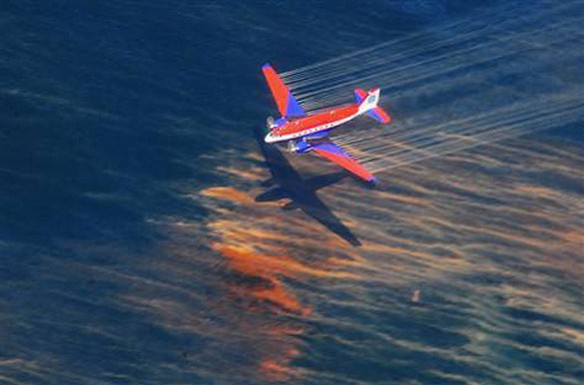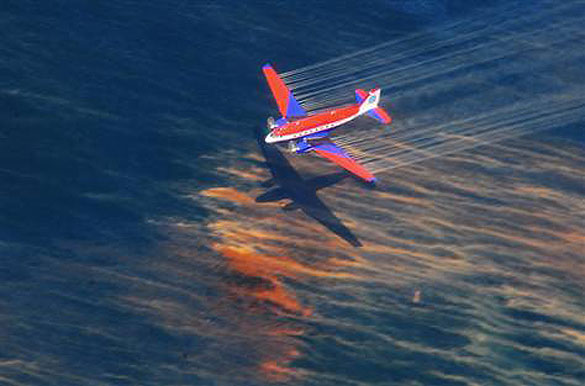
An aircraft releases chemical dispersant over an oil slick in the Gulf of Mexico in 2010. Captions and Photo source: NOAA /US Coast Guards
Excerpts;
New research suggests that Corexit EC9500A, an oil-dispersal agent widely used in the Gulf of Mexico following the Deepwater Horizon oil spill, contributes to damage to epithelium cells within the lungs of humans and gills of marine creatures. The study also identifies an enzyme that is expressed in epithelial cells across species that has protective properties against Corexit-induced damage…
Read Full Article, University of Alabama at Birmingham
Oil Spill Dispersants Shifting Ecosystem Impacts in Gulf, Scientists Warn, The New York Times
A seemingly feel-good story showed up this week on the nation’s front pages and newscasts: The oil that befouled the Gulf of Mexico for 86 days is vanishing from the surface, leaving workers with little to clean. But scientists warn the oil’s ecological impacts are shifting, not ebbing, thanks to massive volumes of dispersants that have kept the crude beneath the waves…
E.P.A : It Was Wise to Use Oil Dispersant, The New York Times (08-03-2010)
Many scientists expressed grave concerns about the unprecedented aerial spraying of chemical dispersants in the Gulf of Mexico region.
First Study of Dispersants in Gulf Spill Suggests a Prolonged Deepwater Fate (01-27-2011)
To combat Deepwater Horizon oil spill, nearly 800,000 gallons of chemical dispersant were injected directly into the oil and gas flow coming out of the wellhead. Scientists begin to assess and to raise questions about what impact the deep-water residue of oil and dispersant, might have had on environment and marine life in the Gulf…
Suit filed seeking more details on dispersants, AP (07-2010)
BP’s use of chemicals to disperse the Gulf of Mexico oil spill is coming under renewed scrutiny, as environmentalists head to court to seek more information about potential health hazards and a Senate panel plans a Thursday hearing on the issue…
Seeking more details on dispersants, The New York Times (07-15-2010)
Gulf Oil Spill: Oil-Dispersing Chemicals Had Little Effect On Oil Surfacing, Science Daily (12-04-2012)
As the Deepwater Horizon incident unfolded, in an effort to prevent the oil from coming to the surface and reaching coastal and marsh ecosystems, chemical dispersants were injected at the wellhead. A new study is the first to examine the effects of the use of unprecedented quantities of dispersants, over such a prolonged period of time in the deep ocean…
Scientists and Academics Call For Immediate Halt of Chemical Dispersants in Gulf, The Ocean Foundation (07-26-2010)
Over 100 scientists and academic institution, research laboratory, conservation organization leaders plus human rights defenders from as far away as Norway and Greece have issued, July 18th, a joint Scientists Consensus Statement on the Use of Chemical Dispersants in the Gulf of Mexico calling for the US Administration to immediately halt chemical aerial spraying in the Gulf region. BP has used nearly two million gallons of Corexit chemical dispersants in the Gulf of Mexico as part of the cleanup effort with support from the U.S. Environmental Protection Agency (EPA). The massive volume of dispersants and the way they have been applied, both on the surface and one mile below the surface, is unprecedented. Once oil is dispersed in deep water, it cannot be recovered. The scientists believe the worst impacts of the disaster are yet to come, and without deliberate, independent scientific tracking and assessment, they could remain hidden…









